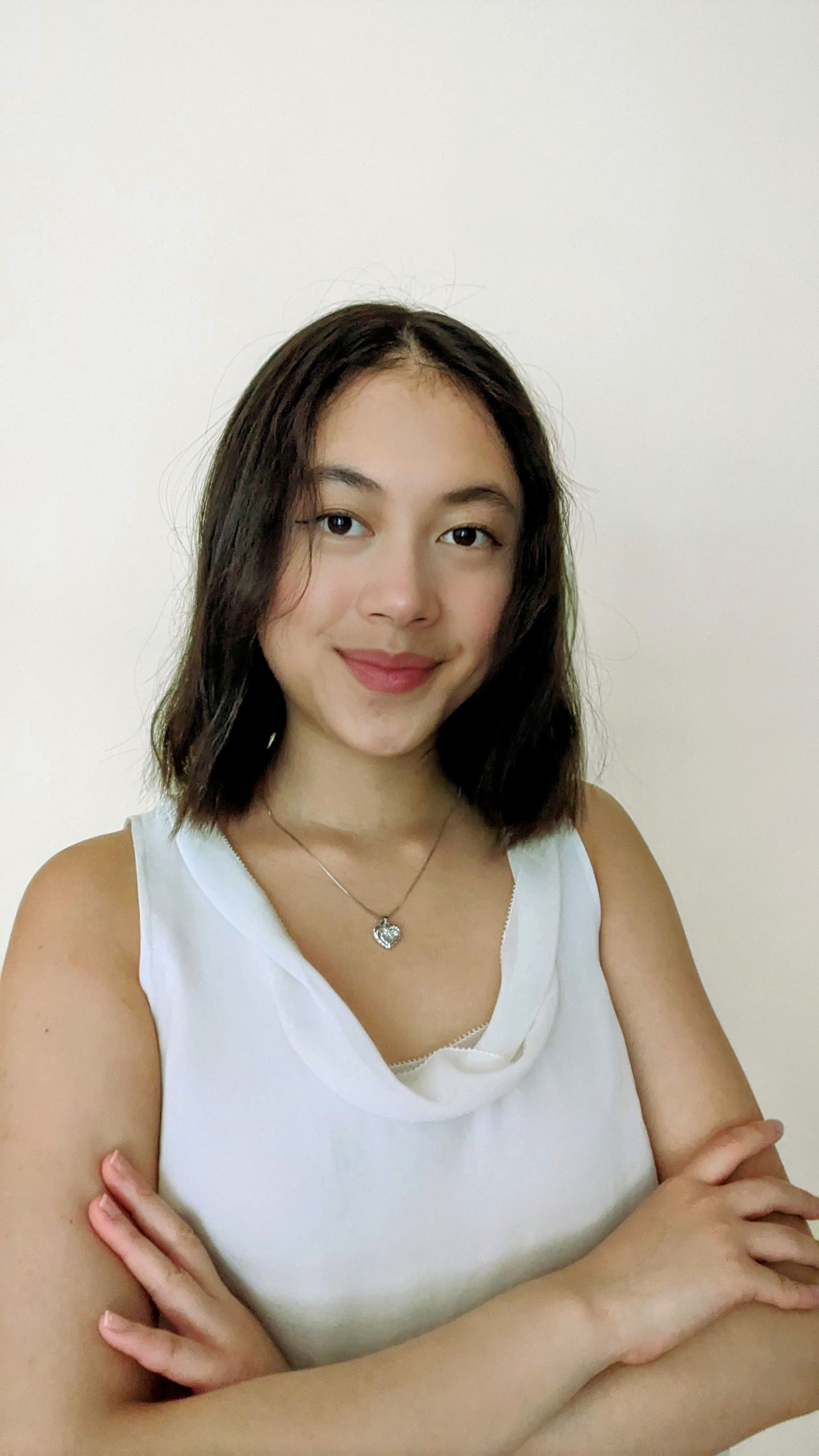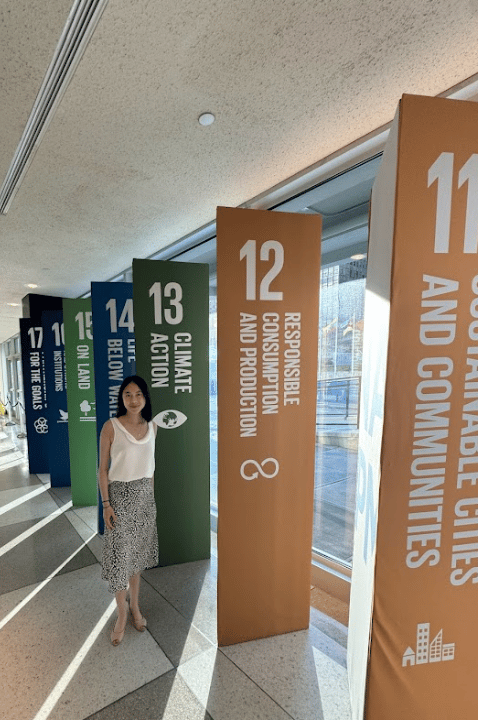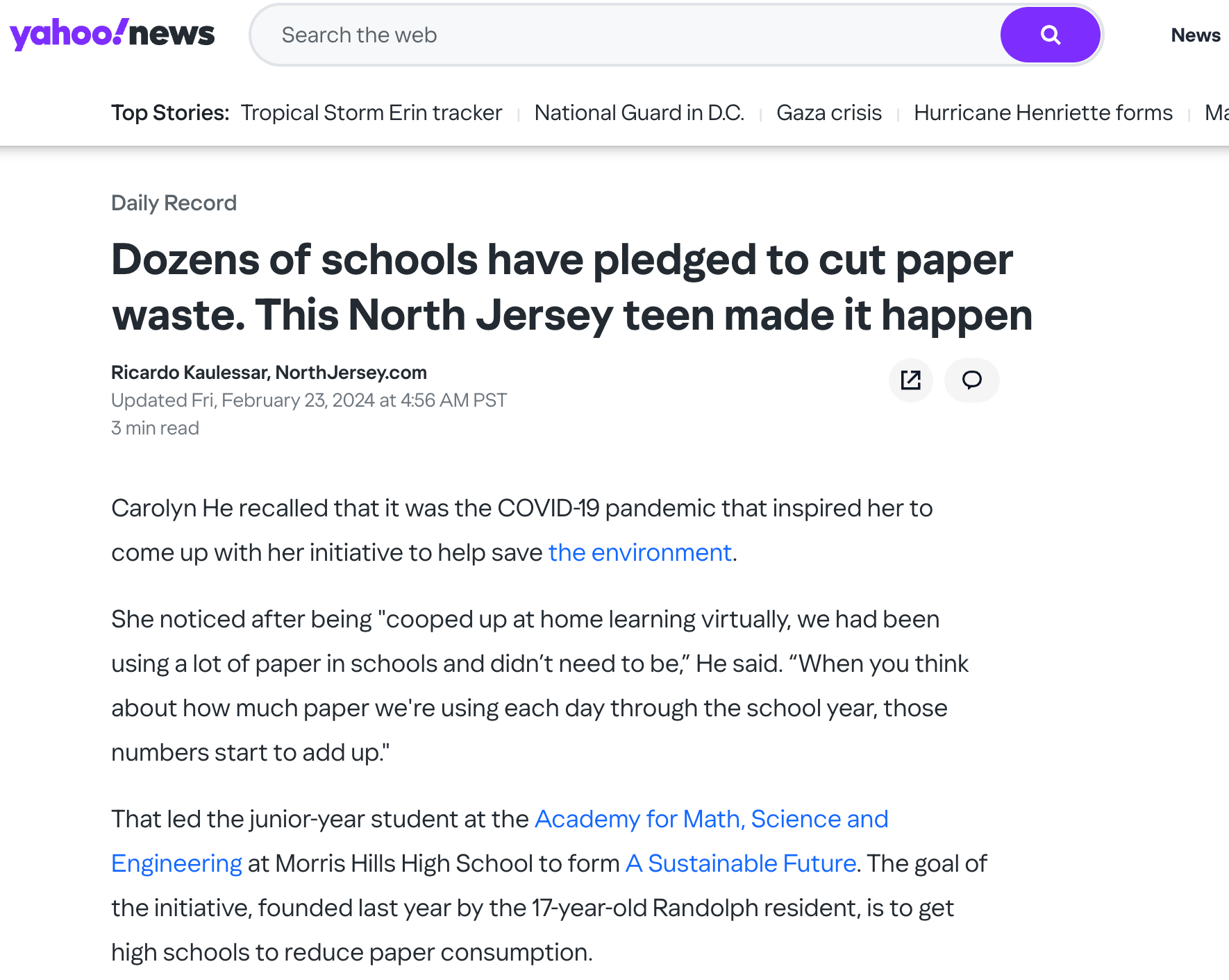- The Impact Journal
- Posts
- This Stanford Student Helped 90+ Schools Save 21 Million Sheets of Paper.
This Stanford Student Helped 90+ Schools Save 21 Million Sheets of Paper.
Carolyn is an incoming freshman who founded "A Sustainable Future (ASF)" which helps schools across the U.S cut down on paper waste.
Carolyn (incoming at Stanford University) founded A Sustainable Future (ASF) to help schools across the U.S. cut down on paper waste and shift toward more mindful, sustainable systems. Her mission began with a simple question: why do schools still print so much when tech alternatives already exist?
Since then, ASF has saved schools over 21,000,000+ sheets of paper, tailored its curriculum to the needs of 90+ campuses, and equipped a new generation of students to lead environmental change in their own communities.
But Carolyn’s work goes far beyond ASF. She holds leadership roles in national organizations like the Jane Goodall Institute’s Roots & Shoots Council, Project Green Schools, and Women in STEM—where she’s led mentorship programs, organized youth panels, and launched outreach campaigns for young women in science.
Let’s hear from Carolyn.
If you’re a current high school student interested in starting your own initiative and standing out in university applications — you can sign up for a 30-minute extracurricular review. During the call, we’ll:
a) Learn about your university goals
b) Review your extracurricular profile
c) Help you shape a unique project idea.
#1: What’s your origin story? What projects helped you step into environmental leadership?

Carolyn: ASF became my main focus, but I’ve always been involved in community-building work—especially around environmentalism and supporting girls in STEM.
In junior and senior year, I joined Project Green Schools, a nationwide network where students earn recognition for taking environmental action on campus. I also served on the Jane Goodall Institute’s Roots & Shoots National Youth Council, which leads Jane Goodall’s youth initiatives.
On the STEM side, I joined Women in STEM in sophomore year. The organization runs in 200+ schools globally and encourages girls to explore science. I helped lead a mentorship program that paired high school students with professionals from academia and industry—over 150 pairings each year. We also organized events for younger girls in elementary and middle school.
Locally, I hosted bi-weekly sessions for Engineer Girl at our community church.
#2: How did you grow ASF into nation-wide sustainability initiative integrated into so many schools?

ASF started at my school after COVID. I noticed something strange: even though we had access to tech tools, we were still printing massive amounts of paper. So I launched a school-wide investigation—and confirmed we were printing way more than we needed.
I pushed for system changes, and eventually, we centralized our printing so that teachers had to use a shared printing center instead of individual printers. That single change reduced our printing and cut costs.
From there, I reached out to more schools. We turned our research and advocacy model into a curriculum that students could use to do the same work on their own campuses. That curriculum became A Sustainable Future. Today, it’s used by over 90 schools.
#3: How did you convince schools—known for red tape and tight budgets—that they didn’t need to print so much?

Carolyn: I will say that getting the data indicating printing frequency & waste was the easy part. The harder—and more important—part was learning how to understand each school community's needs.
I didn’t just talk about environmentalism. I showed how ASF could help schools reduce their own printing costs and save money. That financial angle helped administrators take action.
At my school, we were already exploring digital options after COVID, so pushing for centralized printing fit into that moment. It was easier for me to convince my school.
In other schools, we tailored the solutions—like switching to default double-sided printing or training more students and teachers to use digital tools. That really depended on my own research into different communities and the context in which they exist.
Overall, the key was working directly with students and teachers on the ground. We had to understand what our constituents were capable of and willing to do in order to get the biggest impact.
#4: What common issues kept showing up as you scaled?
Carolyn: We saw the same patterns.
Sometimes schools were more focused on adopting technology — but for others, it was about changing how people made decisions.
For example, in my school, we realized that when we made teachers actively travel to a centralized printer to print, the act of traveling makes them think more critically about whether or not they need paper copies in the first place.
We also found that miscommunication between teachers and students often led to overprinting. For example, teachers might print too many copies just in case—not realizing most students prefer digital formats.
#5: What was the most difficult case you had to take on with a school?

Carolyn: One school faced all three major challenges: administrative, logistical, and financial.
First, they asked us to pay for their printing data, so we helped students fundraise. Once we got the data, we realized it was a mess. The print system only tracked how much each printer produced—not how much each department or teacher printed, which made it difficult to analyze or improve.
We then worked through the usual barriers—meeting with administrators, designing execution plans, and making sure the changes actually worked.
#6: Where do you see ASF going?

Carolyn: I do want to carry this work onto college campuses which have a lot more formalized print management systems. Again, it’s seeing whether schools are actually aware of how much they’re printing and if they are, what steps they’re actively taking to mitigate it.
The main difference with college campuses is that faculty members and students are required to pay to print. I’m curious to see how printing differs when it’s tied directly to an economic incentive and whether that can be incorporated on a smaller scale in secondary education.
#7: Where do you see yourself going? How has ASF shaped your path?
I would definitely say that a lot of what we’re seeing with sustainability and consumerism is tied to convenience. When something is just a little easier or cheaper for people to do, they’ll take that path of least resistance.
I’m still workshopping this idea, but I’d love to create a climate marketplace where consumers are incentivized to look for sustainability as the first option, rather than defaulting to easier alternatives like Amazon just because it’s cheaper.
I think addressing the climate crisis has a large part to do in how we as humans consume resources. A lot of change is going to have to start with the systems themselves.
#8: What’s a word of advice for students pursuing their own organization in the sustainable field?
This might be controversial, but I’d ask yourself: Does your community really need a new initiative?
Your time and energy are limited. Before you start something from scratch, look for existing organizations doing great work and see how you can contribute. You’ll learn faster and create deeper impact.
Also, only build something if it’s a cause you deeply care about. Leading a community or launching an initiative is hard. It often feels like pushing a boulder uphill—not knowing if you’ll ever reach the top. So make sure it’s something you believe in. That passion will carry you through the hard parts.
Want to start a project like Carolyn’s?
If you’re a high school student looking to build something meaningful—and craft a standout application for top universities—we can help.
Book a 30-Minute Extracurricular Strategy Call
During the call, we’ll:
✓ Review your current extracurriculars
✓ Help you clarify your university goals
✓ Work with you to shape a one-of-a-kind initiative and see if there is a fit for our mentorship program.
Keep up with Carolyn:
Linked-In: https://www.linkedin.com/in/carolyn-he/